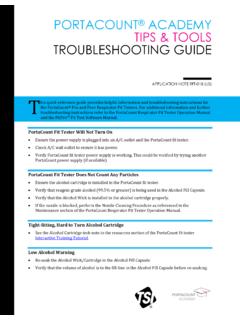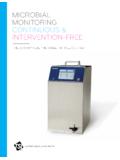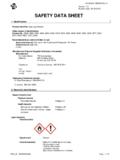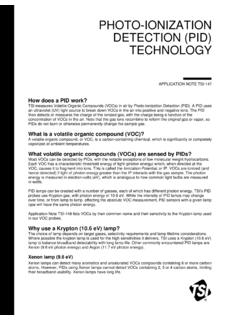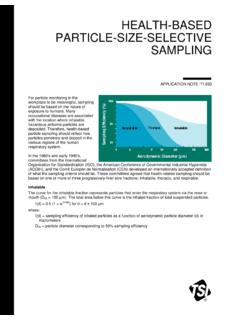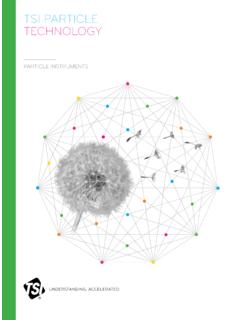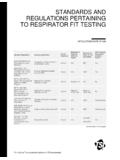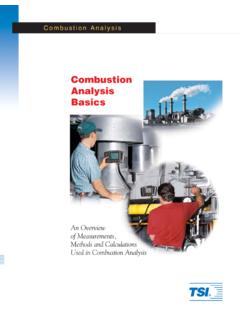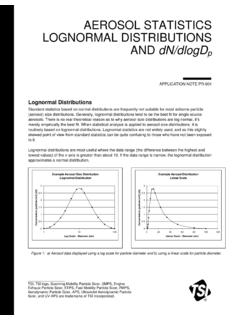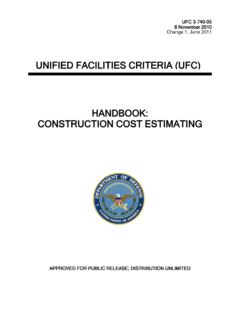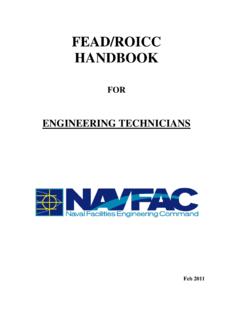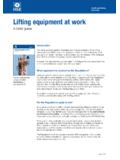Transcription of HVAC ASSESSMENT HANDBOOK - TSI, Inc
1 UNDERSTANDING, ACCELERATEDHVACASSESSMENT HANDBOOKA PRACTICAL GUIDE TO PERFORMANCE MEASUREMENTS IN MECHANICAL HEATING, VENTILATING, AND AIR CONDITIONING SYSTEMS _____ TSI, TSI logo, Alnor, VelcoiCalc and AccuBalance are registered trademarks of TSI Incorporated. IAQ-Calc, DP-Calc, TrakPro, LogDat2, and Airflow Instruments are trademarks of TSI Incorporated. Copyright 2013 by TSI Incorporated hvac ASSESSMENT HANDBOOK A PRACTICAL GUIDE TO PERFORMANCE MEASUREMENTS IN MECHANICAL HEATING, VENTILATING, AND AIR CONDITIONING SYSTEMS hvac ASSESSMENT HANDBOOK i Contents Introduction.
2 1 Building Design and Operation .. 1 Efficiency vs. Effectiveness .. 2 Special Considerations .. 2 Indoor Air Quality .. 3 Outdoor Air .. 3 Key Performance Measurements .. 4 What Air handling equipment .. 4 What Air velocity .. 5 What Ventilation .. 6 What Air volume and number of changes .. 7 What Thermal Comfort .. 9 What Airborne contaminants as related to Indoor Air Quality (IAQ) .. 10 What Differential Pressure .. 11 What System Pressure .. 12 What Air Filters .. 14 Conclusion .. 16 Sources for Information Relating to Managing Mechanical hvac Systems.
3 17 Standards and Guidelines .. 18 National Ambient Air Quality 18 Air Quality Guidelines .. 19 Glossary .. 20 Typical Mechanical Ventilation System .. 21 VTI Instruments from TSI .. 22 Notes .. 27 hvac ASSESSMENT HANDBOOK hvac ASSESSMENT HANDBOOK 1 INTRODUCTION Heating, Ventilating, and Air Conditioning ( hvac ) relates to systems that perform processes designed to regulate the air conditions within buildings for the comfort and safety of occupants or for commercial and industrial processes or for storage of goods. hvac systems condition and move air to desired areas of an indoor environment to create and maintain desirable temperature, humidity, ventilation and air purity.
4 Depending on geographic location and building construction, various types of interior climate control systems help ensure that interior spaces are maintained at comfortable levels year-round. With today s energy conservation concerns, buildings are constructed to be much tighter, reducing the level of natural exchange between indoor and outdoor air. As a result, more and more buildings rely on mechanical conditioning and distribution systems for managing air. A properly operated hvac system finds the often-delicate balance between optimizing occupant comfort while controlling operating costs.
5 Comfort is an important issue for occupant satisfaction, which can directly affect concentration and productivity. At the same time, controlling these comfort and health parameters directly affects hvac system operating costs in terms of energy, maintenance and equipment life. This HANDBOOK is not intended to be a comprehensive guide for all possible issues associated with hvac system operation and maintenance. There are volumes on the subject. Rather, it highlights some measurements and techniques that can be used to evaluate hvac systems for optimum operation.
6 Building Design and Operation Some basic considerations to address when specifying the equipment needed to control and condition the air should include the size and physical layout of the building, which determines equipment requirements such as the size and type of fans, boilers, coils and filters. A thorough understanding of the entire system, from the outdoor air intake to the furthest diffuser is essential to good system design. It is also important to understand the specific purpose of the space and activities taking place. This will greatly influence the building s conditioning requirements.
7 This further dictates appropriate equipment and the capacity needed to meet those requirements. Design parameters must account for cooling load, heating load, ventilation and filtration requirements. Other considerations that directly impact the hvac system include the number of people in each space, interior elements like wall placements, furnishings and equipment that may create barriers to impede airflow and distribution. Internal loads such as lights, computers and other equipment that may produce heat, humidity or otherwise affect ambient air conditions must also be considered.
8 The design of air distribution equipment in today s buildings presents challenges for the mechanical engineer. Equipment selection must combine properly engineered products, which efficiently provide conditioned air to the occupied space while blending in with the architectural features of the interior. Considerable time and money can be spent developing and purchasing the appropriate mechanical components, system controls, ductwork and piping. If components are selected improperly, the hvac system will operate inefficiently, not meet requirements and create cost overruns to correct the situation.
9 Since one aspect of the system affects another, proper selection of every component, regardless of apparent significance, is imperative. hvac ASSESSMENT HANDBOOK 2 TSI Incorporated Efficiency vs. Effectiveness With any mechanical ventilation system, there is a trade-off between optimizing occupant comfort and controlling operating costs. Common measurements for assessing effectiveness or the level of comfort among occupants include a variety of parameters such as temperature, humidity, air velocity, ventilation, vibration and noise. Individual perception plays a significant role since comfort is both physical and psychological and can vary greatly by individual.
10 What is comfortable for one person may be too warm for the next and too cool for a third. When maximizing the operating efficiency of a system, a number of factors must be considered including fuel source and cost, electrical consumption, air filtration, equipment life, maintenance costs and more. These expenditures are often very visible. Controlling them has a direct impact on the day-to-day cost of building operation and can impact a company s profitability. Reducing hvac operating expenditures to a point where occupants are dissatisfied has other costs associated with it, including increased costs due to absenteeism, loss of people due to employee turnover, recruiting, training and decreased productivity to name but a few.

